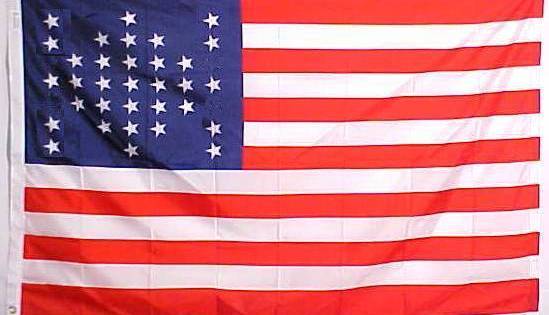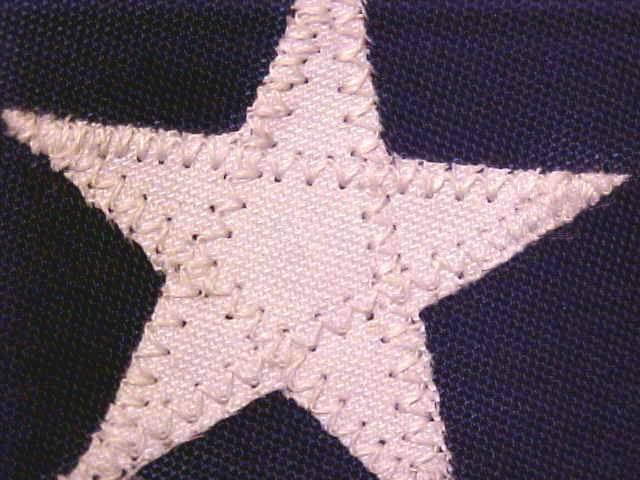Fort Sumter Flag
She was there at the beginning, and she was there at the end.

Very Unique, 33-Star Pattern with Cocked Stars
|
|
3x5' Nylon with Heading and Grommets $99.00 #H27S
|
"Charleston 1861: The Other Star-Spangled Banner" by William F.B. Vodrey Copyright (c) 2003, 2005 All rights reserved Cleveland Civil War Roundtable.
http://www.clevelandcivilwarroundtable.com/
On April 14, 1861, after an extensive bombardment, the outnumbered and outgunned Union garrison of Ft. Sumter surrendered to the Confederate forces in and around Charleston harbor. U.S. Army Maj. Robert Anderson insisted, as a condition of his troops' surrender, that they be permitted to fire a 100-gun salute to the huge United States flag that had so defiantly flown over the fort during the battle. Confederate Gen. Pierre Gustave Toutant Beauregard agreed to the demand of Anderson, his former West Point artillery instructor. The Union guns began firing the salute, but on the 47th round, Union Army Private Daniel Hough was killed in the accidental explosion of a pile of cartridges; five others were wounded. Hough was the first casualty of the Civil War. The salute was promptly reduced to 50 rounds. Maj. Anderson and his troops then boarded a steamship and sailed north, with the flag, into history.
Anderson was a Kentuckian like Abraham Lincoln and Jefferson Davis, and like Lincoln, he remained loyal to the United States. He wrote, "Our Southern brethren have done grievously wrong; they have rebelled and attacked their father's house and their loyal brothers. They must be punished and brought back, but this necessity breaks my heart."
Anderson toured the North with the 33-Star Garrison Flag, and men young and old flocked to the colors, eager to fight for "Lincoln and liberty." The Ft. Sumter flag was an extraordinarily popular and powerful symbol of the Union, and some historians trace the beginning of our country's long admiration - if not veneration - of the American flag to the early patriotic fervor of the Civil War. Anderson brought the flag to New York City for an April 20, 1861 patriotic rally, where it was flown from the equestrian statue of George Washington. More than 100,000 people thronged Manhattan's Union Square in what was, by some accounts, the largest public gathering in the country up to that time. The flag was taken from town to town, city to city throughout the North, where it was frequently "auctioned" to raise funds for the war effort. Any patriotic citizen who won the flag at auction was expected to immediately donate it back to the nation, and it would promptly be taken to the next rally to repeat its fundraising magic.
In time, the Confederacy faltered and Union victory became certain. After Charleston fell and the war drew to a close, there was a grand celebration in the former "cradle of secession." On April 14, 1865, Union officers and dignitaries gathered at Ft. Sumter. A band played, several nearby Navy warships fired salutes, and there were hymns and prayers. Then, exactly four years to the day after he'd lowered the flag in surrender, Gen. Robert Anderson raised it in triumph over the fort's battered and shot-torn walls. The flag was transformed into a symbol of a restored and victorious United States.
The Rev. Henry Ward Beecher was the principal orator at the celebration, and gave a long speech, as was the custom of the day. He said, "On this solemn and joyful day, we again lift to the breeze our fathers' flag, now, again, the banner of the United States, with the fervent prayer that God would crown it with honor, protect it from treason, and send it down to our children.... Terrible in battle, may it be beneficent in peace [and] as long as the sun endures, or the stars, may it wave over a nation neither enslaved nor enslaving.... We lift up our banner, and dedicate it to peace, Union, and liberty, now and forevermore." The crowd responded with great applause.
That night, fireworks brightened the skies over Charleston harbor. Almost five hundred miles to the north, President Lincoln went with his wife to Ford's Theatre for the last time.
The original 33-Star Garrison Flag is now on display in Ft. Sumter's museum, a bookend, if you will, to the beginning and end of America's great national tragedy. A replica of the flag flies daily above the fort, along with other historic flags. I have a small replica of the flag, which the Roundtable gave me at the conclusion of my term as president. At my request, Superintendent John Tucker of the Ft. Sumter National Monument arranged for my flag to be flown above the fort on April 14, 2002, the 141st anniversary of the flag's lowering and the 137th anniversary of its re-raising. As Tucker wrote to me, "Through the stories behind [our] flags, we are able to learn and remember significant people and events of the past. This 33-star flag is one of the most historic and memorable symbols of our nation's heritage."
He's right. Long may it wave.
The url for this page is http://flagguys.com/sumter.html
